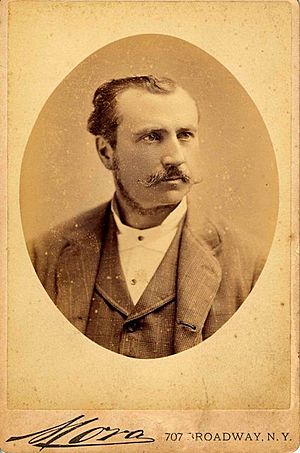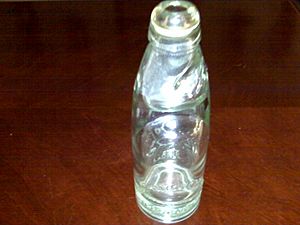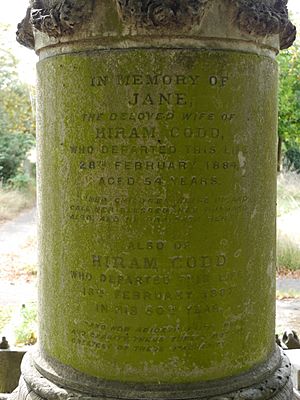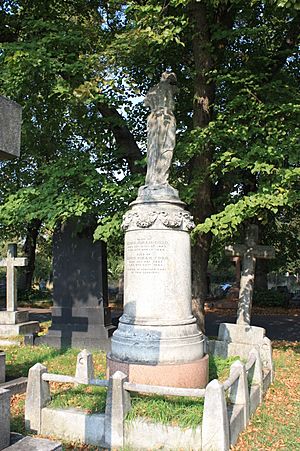Hiram Codd facts for kids
Quick facts for kids
Hiram Codd
|
|
|---|---|

Hiram Codd
|
|
| Born | 10 January 1838 |
| Died | 18 February 1887 (aged 49) Brixton Road, Brixton, London, England
|
| Occupation | Inventor |
| Known for | Seals for carbonated beverages |
Hiram Codd (born January 10, 1838 – died February 18, 1887) was a clever English engineer and inventor. He is famous for creating a special bottle in 1872. This bottle used gas pressure to push a marble against a rubber ring, sealing in fizzy drinks. People soon called it the Codd bottle.
Contents
Early Life and Big Ideas
Hiram Codd was born in Bury St Edmunds, a town in Suffolk, England. His father, Edwin Codd, was a carpenter who passed away when Hiram was only eight years old. Hiram had two older brothers and an older sister.
When he was 18, in 1856, he married Jane Colebrooke in London. Hiram became a mechanical engineer. At 23, while working for a company that made corks, he found ways to make cork production much better. He soon realized there was a need for improved machines to fill bottles and new ways to seal them without always needing corks.
Inventing the Codd Bottle
Hiram Codd was always thinking of new inventions. In 1862, he got a patent for a way to measure how liquids flow. By 1870, he had designed a special machine for bottling drinks.
To make sure his inventions worked well, he experimented at a small factory that made mineral water in London. In 1870, official papers showed he was a soda water maker.
Two people named Frederick Foster and William Brooke helped Hiram early on. In 1872, he met Richard Barrett, whose sons owned a mineral water company. Barrett became Hiram's business partner. This partnership helped Hiram keep working on his idea for a bottle with a glass ball (or globe-stopper) inside. By 1873, he had perfected his unique globe-stoppered bottle.
Companies that wanted to use Hiram Codd's special bottles had to pay a yearly fee. By mid-1873, 20 companies had licenses, and 50 more wanted them! A big trade show in London that year made his bottles even more popular. By 1874, bottle makers could use his patent for free, as long as they bought the marbles and sealing rings from him and used his special tool. Hiram even had two factories in London just for making the glass marbles!
Hope Glass Works and Later Years
In 1873, Hiram Codd met Ben Rylands. In 1877, they became partners and opened the Hope Glass Works in Barnsley, a factory that made glass. They worked together until Ben Rylands passed away in 1881.
Hiram also continued his partnership with Richard Barrett. When Barrett retired in 1881 due to poor health, Hiram took over running all of Codd's patents. His mineral water factory and marble factories kept doing very well.
In 1880, Hiram came up with the idea of a "bottle exchange" in London. This meant that empty bottles could be returned to their original owners through special agents. It was slow to start, but soon bottle exchanges became popular all over the country. This helped companies reuse their bottles and save money.
After Ben Rylands died, his son, Dan Rylands, took over the partnership. In 1882, they patented a new type of Codd bottle called 'the crystal'.
In 1884, Hiram sold his share of the business to his partner and started a new trading company in London. Sadly, his first wife died that same year. They had four children who survived: Ada Louisa, Maud M, Edith J, and Alfred Charles. Hiram married his second wife, Elizabeth Brundell, in 1885.
Hiram Codd chose not to renew his early patents. This meant that other companies could now make bottles similar to his without any legal issues. Some of these older bottles even have "CODD'S EXPIRED PATENT" written on them.
Death and Lasting Impact
Hiram Codd passed away on February 18, 1887, at his home in London. He was buried in London's Brompton Cemetery. His family's monument can be found there.
Even today, Codd's patented globe stopper bottle is still made in India by the Khandelwal glass works. Old Codd bottles are very popular with people who collect antique bottles all over the world.
Codd-neck bottles are also still made in large numbers for a popular Japanese soft drink called Ramune. This shows how important and long-lasting Hiram Codd's invention truly was!





